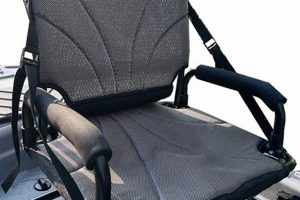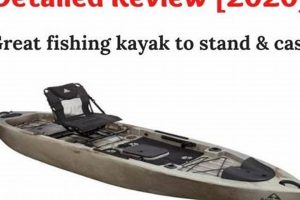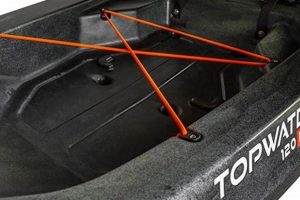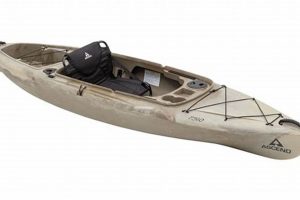Kayaks designed for angling and capable of supporting substantial loads offer anglers the ability to carry additional gear, including larger catches, fishing equipment, and safety devices. These specialized vessels typically feature wider beams and robust construction compared to recreational kayaks, providing enhanced stability and buoyancy.
The capacity to accommodate heavier payloads offers significant advantages for anglers. Enhanced stability improves safety, especially in challenging conditions or when handling large fish. The ability to carry more gear expands fishing opportunities, allowing for longer trips, diverse tackle options, and preparedness for varied weather. Historically, anglers have adapted various watercraft for fishing. The development of specialized kayaks specifically designed for this purpose, incorporating high weight capacity, has greatly expanded accessibility and improved the angling experience.
This article will further explore the key features, design considerations, and selection criteria relevant to these specialized watercraft, providing readers with the knowledge necessary to make informed purchasing decisions and maximize their on-the-water angling experience.
Tips for Selecting Kayaks Designed for Angling and Enhanced Load Capacity
Choosing a suitable kayak for fishing requires careful consideration of several factors. These tips offer guidance for selecting a vessel optimized for both angling and substantial carrying capacity.
Tip 1: Consider the Total Weight. Calculate the combined weight of the angler, all fishing gear, anticipated catches, and safety equipment. Select a kayak with a weight capacity exceeding this total for optimal safety and performance.
Tip 2: Evaluate Hull Design. Wider hulls generally offer greater stability, particularly important when carrying heavier loads. Consider the intended fishing environment; flatter hulls are suitable for calm waters, while V-shaped hulls perform better in choppy conditions.
Tip 3: Assess Storage Options. Ample storage is crucial for fishing gear. Consider dedicated compartments, tank wells, and mounting options for rod holders and other accessories. Ensure easy access to essential equipment while maintaining balance.
Tip 4: Examine Construction Materials. Durable materials like polyethylene and composites offer varying degrees of strength and weight. Polyethylene kayaks tend to be more robust, while composites provide lighter weight and increased maneuverability.
Tip 5: Consider Seating Comfort. Long fishing trips require a comfortable and supportive seat. Adjustable seating and ample back support are essential for extended periods on the water.
Tip 6: Factor in Propulsion Options. Paddle kayaks offer excellent exercise and control, while pedal-powered and motorized options provide increased speed and range, particularly beneficial when carrying heavy loads.
Tip 7: Test Before Purchasing. If possible, test different kayaks to assess stability, comfort, and maneuverability. Simulate real-world fishing conditions by carrying similar weight and equipment during the test.
By carefully considering these factors, anglers can select a kayak optimized for their individual needs and fishing style, maximizing both safety and enjoyment on the water.
In conclusion, selecting the appropriate kayak is a critical decision for any angler. Understanding the interplay between weight capacity, hull design, and other key features ensures a successful and enjoyable fishing experience.
1. Stability
Stability is a paramount concern in kayak fishing, directly influencing safety and angling success. A stable platform allows anglers to cast, reel, and land fish effectively while minimizing the risk of capsizing. High weight capacity plays a crucial role in enhancing stability, particularly when dealing with larger catches, challenging water conditions, or carrying substantial gear.
- Center of Gravity
A lower center of gravity enhances stability. Kayaks designed for higher weight capacities often feature wider beams and lower profiles, contributing to a lower center of gravity. This design element is essential for maintaining balance, especially when shifting weight during casting or reeling.
- Hull Design
Hull design significantly influences stability. Wider, flatter hulls generally offer greater primary stability (initial resistance to tipping), making them suitable for calm waters. However, they may be less maneuverable. Kayaks with a higher weight capacity often utilize wider hulls to maximize stability, ensuring a secure platform even with heavier loads.
- Weight Distribution
Evenly distributing weight within the kayak is critical for maintaining optimal stability. High-capacity kayaks offer more storage space, allowing for strategic gear placement to optimize weight distribution and balance. This is particularly important when carrying heavier items, preventing the kayak from becoming unbalanced and difficult to control.
- Water Conditions
Water conditions significantly impact stability. Calm lakes and rivers present fewer challenges compared to choppy ocean waters or fast-flowing currents. Kayaks with higher weight capacities often exhibit enhanced stability in rougher conditions due to their increased buoyancy and wider hulls. This added stability provides a safer and more confident fishing experience in challenging environments.
In conclusion, stability is intrinsically linked to weight capacity in fishing kayaks. A kayak’s ability to remain stable under load directly influences angling success and safety. Understanding the factors that contribute to stability, such as center of gravity, hull design, and weight distribution, empowers anglers to choose a kayak best suited to their needs and fishing environment. A stable platform provides a secure foundation for casting, reeling, and landing fish, ultimately enhancing the overall fishing experience.
2. Gear Storage
Ample and well-designed gear storage is essential for fishing kayaks, particularly those designed for higher weight capacities. Effective storage solutions allow anglers to carry a wider array of equipment, enhancing versatility and preparedness on the water. The relationship between gear storage and weight capacity is symbiotic; increased capacity necessitates efficient storage solutions, while ample storage facilitates carrying the additional weight of essential fishing gear.
- Storage Capacity & Types
Storage capacity directly impacts the amount of gear an angler can carry. High-capacity kayaks often feature larger storage wells, dedicated compartments for tackle boxes, and integrated rod holders. These features enable anglers to organize and secure various items, including rods, reels, tackle boxes, safety equipment, and even camping gear for extended trips. The type and configuration of storage compartments influence accessibility and weight distribution, impacting both convenience and kayak stability.
- Accessibility & Organization
Easy access to frequently used gear is crucial for efficient angling. Well-designed storage systems prioritize accessibility, allowing anglers to retrieve necessary items quickly and without compromising balance. Features like readily accessible hatches, strategically placed compartments, and bungee cord systems enhance organization and minimize disruption during fishing. Efficient organization contributes to a safer and more productive fishing experience, particularly in challenging conditions.
- Weight Distribution & Balance
Proper weight distribution within the kayak is critical for stability and maneuverability. Strategically placed storage compartments allow anglers to distribute gear evenly, minimizing the risk of tipping or creating an unbalanced feel. High-capacity kayaks often feature multiple storage areas, enabling anglers to balance weight fore and aft, optimizing performance and safety. Effective weight distribution is especially important when carrying heavier loads, ensuring a stable and controlled fishing experience.
- Waterproofing & Protection
Protecting gear from water damage is paramount in kayak fishing. High-capacity kayaks often incorporate waterproof hatches, sealed compartments, and dry bags to safeguard sensitive electronics, tackle, and other essential items. These features ensure that gear remains dry and functional, even in wet conditions or the event of a capsize. Reliable waterproofing contributes to the longevity of equipment and enhances the overall fishing experience.
In summary, gear storage is a critical consideration in fishing kayaks, particularly those with high weight capacities. The ability to carry and organize essential equipment directly impacts angling versatility, preparedness, and overall success. By carefully evaluating storage capacity, accessibility, weight distribution considerations, and waterproofing features, anglers can select a kayak optimized for their specific needs and fishing style. Effective gear storage enhances efficiency, safety, and enjoyment on the water, contributing significantly to a positive and productive fishing experience.
3. Target Species
The intended target species significantly influences the selection of a fishing kayak, particularly concerning weight capacity. Larger species necessitate kayaks capable of handling increased weight from the catch itself, as well as the heavier tackle often required. Understanding this relationship is crucial for optimizing both angling success and safety.
- Larger Fish, Higher Capacity
Targeting larger fish like muskie, salmon, or striped bass necessitates a kayak with a significantly higher weight capacity. These species can exert considerable force, requiring robust tackle and increasing the overall load on the vessel. A kayak with insufficient capacity may become unstable or difficult to maneuver when battling a large fish, compromising both safety and the likelihood of a successful landing.
- Smaller Species, Flexibility in Capacity
Anglers targeting smaller species like panfish or trout have more flexibility in weight capacity requirements. Lighter tackle and smaller catches reduce the overall load, allowing for the use of kayaks with lower weight capacities. This flexibility can open up options for smaller, more maneuverable kayaks, which may be advantageous in certain fishing environments.
- Multi-Species Anglers, Balancing Act
Anglers targeting a variety of species must strike a balance in weight capacity selection. A kayak with a moderately high weight capacity can accommodate the occasional larger catch while remaining manageable for targeting smaller species. Careful consideration of the most frequently targeted species and their associated gear requirements is essential for optimizing capacity selection.
- Gear Considerations
Target species influence not only the size and weight of the catch but also the required gear. Larger species often necessitate heavier rods, reels, and tackle, further increasing the overall load on the kayak. Anglers must factor these gear considerations into their weight capacity calculations to ensure adequate stability and performance. For example, offshore fishing for large pelagic species requires substantially more robust tackle compared to freshwater fishing for smaller species, significantly impacting weight capacity needs.
In conclusion, the relationship between target species and kayak weight capacity is a critical factor in kayak selection. Careful consideration of the intended catch, associated gear requirements, and the fishing environment ensures a safe, stable, and ultimately successful angling experience. Choosing the appropriate weight capacity based on target species optimizes performance, allowing anglers to confidently pursue their desired catch while maintaining stability and control on the water.
4. Material Durability
Material durability is a critical factor in fishing kayaks designed for high weight capacities. These kayaks must withstand not only the stresses of heavier loads but also the rigors of the fishing environment, including impacts, abrasion, and exposure to the elements. The choice of material directly impacts the kayak’s longevity, performance, and overall value.
- Polyethylene (PE)
Polyethylene is a common material in kayak construction due to its affordability, durability, and impact resistance. Rotational molding creates a seamless, highly durable hull capable of withstanding significant abuse. In high-capacity fishing kayaks, thicker PE is often used to enhance rigidity and load-bearing capabilities, making it suitable for challenging environments and heavier anglers. However, PE kayaks can be heavier than those constructed from other materials.
- High-Density Polyethylene (HDPE)
High-density polyethylene offers enhanced durability and stiffness compared to standard polyethylene. This increased rigidity is particularly advantageous in high-capacity kayaks, as it helps maintain hull shape under heavier loads and improves tracking performance. HDPE kayaks are well-suited for anglers carrying substantial gear or frequently navigating challenging waters. The added durability comes at a slightly higher cost but often translates to a longer lifespan.
- Composites (Fiberglass, Carbon Fiber, Kevlar)
Composite materials offer a lighter and more performance-oriented option for fishing kayaks. Fiberglass, carbon fiber, and Kevlar provide exceptional strength-to-weight ratios, resulting in faster, more responsive kayaks. While generally more expensive than polyethylene, composites offer superior performance characteristics. In high-capacity designs, composites enable the creation of lighter kayaks capable of carrying substantial loads without sacrificing maneuverability. However, composites may be less resistant to impacts and abrasion compared to polyethylene.
- Thermoformed ABS
Thermoformed ABS (acrylonitrile butadiene styrene) is a durable and impact-resistant plastic used in some kayak construction. This material offers a good balance between durability and weight, making it suitable for high-capacity fishing kayaks. Thermoformed ABS kayaks often feature a multi-layer construction for enhanced stiffness and impact resistance, providing a durable platform for anglers carrying heavier loads. While generally less expensive than composites, thermoformed ABS may be less resistant to UV degradation than polyethylene.
Material selection directly impacts the long-term performance and value of a high-capacity fishing kayak. Understanding the properties of each material allows anglers to choose a kayak best suited to their individual needs and budget. Factors like durability, weight, cost, and intended usage should all be considered when evaluating material options. The right material ensures the kayak can withstand the demands of carrying heavier loads and navigating diverse fishing environments, contributing to a safe, enjoyable, and ultimately successful angling experience.
5. Propulsion Method
Propulsion method is a critical consideration for fishing kayaks, particularly those designed for higher weight capacities. The chosen method significantly impacts speed, range, maneuverability, and overall fishing experience, especially when carrying heavier loads. Different propulsion systems offer distinct advantages and disadvantages, influencing an angler’s ability to navigate various water conditions and access desired fishing locations.
- Paddle Propulsion
Traditional paddle propulsion offers excellent maneuverability and control, advantageous in shallow water, tight spaces, and areas with heavy vegetation. However, paddling with a heavy kayak, especially against wind or current, can be strenuous. While requiring physical exertion, paddling allows for stealthy approach, a significant advantage when targeting wary fish. For high-capacity kayaks, efficient paddle strokes and proper technique become crucial for conserving energy and maximizing performance.
- Pedal Propulsion
Pedal-powered kayaks offer hands-free operation, allowing anglers to focus on fishing. These systems provide increased speed and range compared to paddling, particularly beneficial when covering long distances or carrying heavier loads. Pedal drives, utilizing either fins or propeller systems, offer efficient propulsion and reduce fatigue. However, pedal kayaks can be heavier and more expensive than traditional paddle kayaks, and their underwater components may be susceptible to damage in shallow or obstacle-filled waters. For high-capacity kayaks, the added speed and range of pedal propulsion can significantly expand fishing opportunities.
- Motorized Propulsion
Motorized kayaks offer the greatest speed and range, allowing anglers to access distant fishing spots quickly and effortlessly. Electric motors provide quiet operation and are environmentally friendly, while gasoline-powered motors offer greater range. The added weight of a motor and battery system, however, must be factored into the kayak’s overall weight capacity. Motorized kayaks offer significant advantages for anglers carrying heavy gear or fishing in larger bodies of water. The ease of propulsion allows anglers to conserve energy and focus on fishing, particularly beneficial in challenging conditions or when covering long distances.
- Hybrid Propulsion
Some kayaks offer hybrid propulsion systems, combining paddle power with either pedal or motor options. This versatility allows anglers to adapt to changing conditions or personal preferences. For example, an angler might paddle in shallow, quiet areas and then utilize the motor for longer transits or when facing strong headwinds. Hybrid systems provide flexibility but often come at a higher cost and increased complexity. For high-capacity kayaks, a hybrid approach offers the advantages of multiple propulsion methods, allowing anglers to optimize their approach based on specific fishing scenarios.
The choice of propulsion method significantly impacts the overall fishing experience, especially with high-capacity kayaks. Careful consideration of factors such as fishing style, target species, water conditions, and personal preferences is essential for selecting the most appropriate propulsion system. The right propulsion method enhances efficiency, expands fishing opportunities, and contributes to a more enjoyable and productive time on the water. Balancing the advantages and disadvantages of each system ensures anglers can maximize their time fishing and effectively utilize the increased carrying capacity of their kayaks.
6. User Comfort
User comfort is a crucial factor influencing the overall fishing experience, especially in kayaks designed for high weight capacities. These kayaks are often used for extended trips and in demanding conditions, making comfort essential for maintaining focus and maximizing enjoyment. Discomfort can lead to fatigue, reduced performance, and even potential health issues, highlighting the direct link between user comfort and a successful fishing outing. Consider an angler battling a large fish in a high-capacity kayak; an uncomfortable seating position can hinder their ability to maintain balance and effectively fight the fish, potentially leading to a lost catch or even a dangerous situation. Conversely, a comfortable and supportive seat allows the angler to focus on the task at hand, increasing their chances of success and ensuring a safer experience.
Several factors contribute to user comfort in high-capacity fishing kayaks. Seat design plays a pivotal role; adjustable seating systems with ample padding and lumbar support accommodate individual preferences and body types, promoting proper posture and reducing strain. Footrest positioning is equally important; adjustable footrests allow anglers to maintain a stable and comfortable paddling position, preventing leg fatigue and improving overall control. Storage accessibility also contributes to comfort; easily accessible storage compartments minimize the need for awkward reaching or bending, reducing strain and enhancing efficiency. For example, an angler needing to frequently access tackle stored in a poorly designed compartment may experience back pain or discomfort, hindering their ability to focus on fishing. A well-designed storage system allows for effortless access, promoting comfort and maximizing fishing time.
Understanding the relationship between user comfort and high-capacity kayak design empowers anglers to make informed purchasing decisions. Prioritizing comfort features, such as adjustable seating, footrests, and strategically placed storage compartments, ensures a more enjoyable and productive fishing experience. While high weight capacity is crucial for carrying gear and larger catches, neglecting user comfort can compromise the overall experience. Investing in a comfortable kayak allows anglers to fully enjoy extended trips, focus on fishing, and minimize the risk of fatigue or injury. By prioritizing comfort, anglers can maximize their time on the water and create a more positive and rewarding fishing experience.
Frequently Asked Questions
This section addresses common inquiries regarding kayaks designed for angling and enhanced load capacity.
Question 1: How is the weight capacity of a fishing kayak determined?
Manufacturers determine weight capacity through rigorous testing, considering factors like hull design, material strength, and stability. The stated capacity represents the maximum weight the kayak can safely support while maintaining adequate freeboard and stability.
Question 2: What factors beyond the angler’s weight influence the necessary capacity?
Essential gear, including rods, reels, tackle boxes, and safety equipment, contributes significantly to the total load. Anticipated catch weight must also be considered. Overloading compromises stability and performance, jeopardizing safety.
Question 3: Does a higher weight capacity necessarily equate to increased stability?
While weight capacity influences stability, it is not the sole determinant. Hull design, width, and length also play critical roles. Wider, flatter hulls generally offer greater stability, particularly beneficial in high-capacity kayaks designed to carry heavier loads.
Question 4: How does material choice affect weight capacity and performance?
Different materials offer varying strength-to-weight ratios. Polyethylene provides durability and affordability, while composites offer lighter weight and enhanced performance, often at a higher cost. Material selection influences both capacity and overall kayak characteristics.
Question 5: What are the implications of exceeding the stated weight capacity?
Exceeding the stated capacity compromises stability, reduces freeboard, and increases the risk of capsizing. Performance suffers, affecting maneuverability and responsiveness. Operating within the specified weight limits is crucial for safety and optimal performance.
Question 6: How does weight capacity relate to intended fishing environment?
Calm waters generally require less stability, offering flexibility in weight capacity. Challenging conditions, such as ocean surf or fast-flowing rivers, necessitate higher capacity and enhanced stability for safety and effective angling.
Selecting a fishing kayak with the appropriate weight capacity is crucial for safety, performance, and overall angling experience. Careful consideration of individual needs, target species, and intended fishing environment ensures informed decision-making.
For further information on specific models and features, consult detailed product specifications and expert reviews.
Conclusion
Fishing kayaks with high weight capacity offer distinct advantages for anglers seeking enhanced stability, increased gear storage, and the ability to pursue larger species. Careful consideration of factors such as hull design, material durability, propulsion method, and user comfort is essential for selecting the appropriate vessel. Understanding the interplay of these elements empowers anglers to optimize their on-the-water experience.
Successful angling relies on informed decision-making. Thorough research and thoughtful consideration of individual needs, target species, and intended fishing environment are crucial steps toward selecting a fishing kayak that maximizes both safety and angling success. The right kayak enhances not only the practical aspects of fishing but also the overall enjoyment and connection with the natural world.






